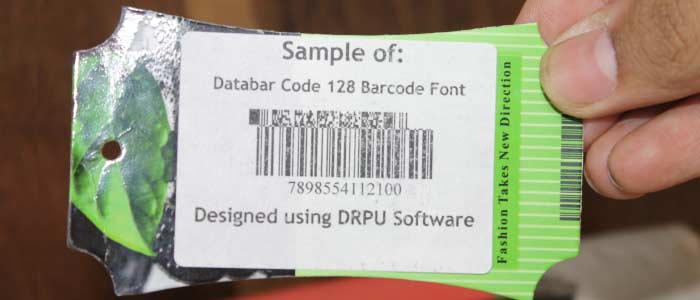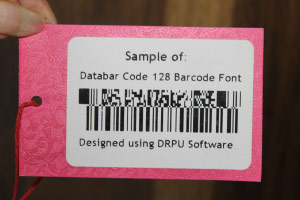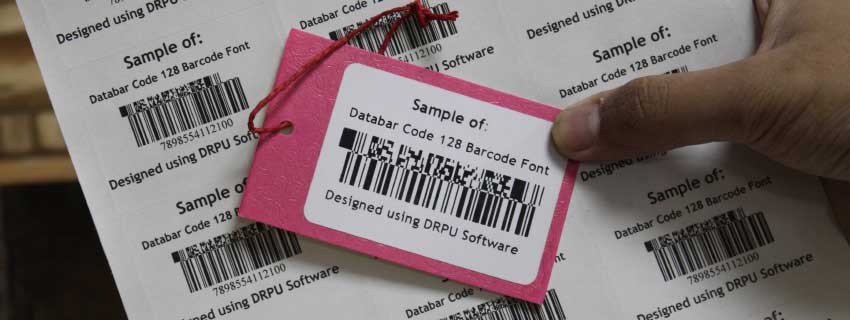DataBar Code 128 is a type of barcode that is used to store and retrieve data in a wide range of applications, such as retail, healthcare, and logistics. It is a linear, 1D barcode that can encode both numeric and alphanumeric characters, and can be read by a barcode scanner or reader.
In this article, we will discuss the DataBar Code 128 barcode in detail, including its history, encoding methods, applications, and advantages.DataBar Code 128 barcode was first introduced in 2006 by GS1, an international organization that develops and maintains global standards for the identification and communication of products, services, and locations. The barcode was designed to replace the existing Reduced Space Symbology (RSS) barcode, which had limited data capacity and was not suitable for small-sized products.
DataBar Code 128 barcode was specifically designed for small items such as fresh produce, meat, and dairy products, as well as coupons and other promotional materials. The barcode is also used in healthcare applications to encode patient information, medication data, and medical device tracking.
DataBar Code 128 barcode can encode both numeric and alphanumeric characters, as well as special characters such as punctuation marks and symbols. The barcode uses different encoding methods depending on the type of data being encoded.
Numeric data is encoded using a subset of the Code 128 symbology known as Code 128 A. This subset includes the numbers 0-9 and special characters such as space, dash, and period.
Alphanumeric data is encoded using another subset of Code 128 known as Code 128 B. This subset includes uppercase letters A-Z, lowercase letters a-z, and numeric characters 0-9, as well as some special characters.
Extended Code 128 is used to encode data that is not included in either Code 128 A or Code 128 B subsets. This subset includes all ASCII characters and provides the most comprehensive encoding options for the DataBar Code 128 barcode.
DataBar Code 128 barcode is widely used in retail applications, particularly for small-sized products such as fresh produce, meat, and dairy products. The barcode allows for more information to be stored in a smaller space, enabling retailers to track inventory, manage pricing, and automate the checkout process.
DataBar Code 128 barcode is also used in healthcare applications, particularly for patient identification, medication tracking, and medical device tracking. The barcode provides a reliable and efficient method for healthcare providers to access patient data and ensure accurate medication administration.
In addition, DataBar Code 128 barcode is used in logistics and supply chain management to track products and shipments. The barcode provides a standardized method for identifying and tracking products, enabling more efficient inventory management and supply chain operations.
Download and Install Barcode Software for Windows
Difference of Databar Code 128 Barcode from Other Barcode Systems
DataBar Code 128 barcode is a type of linear barcode that is used to encode data for a variety of applications, including retail, healthcare, and logistics. While there are many different types of barcodes, DataBar Code 128 barcode is unique in several ways.

-
Data Encoding
One of the key differences between DataBar Code 128 barcode and other barcode types is the way in which data is encoded. DataBar Code 128 barcode uses a system of bars and spaces of varying widths to represent data, with each character being represented by a specific pattern of bars and spaces.
In contrast, other barcode types, such as QR codes and Data Matrix codes, use a matrix of dots or squares to represent data. Each dot or square represents a bit of data, with the entire code consisting of a grid of these dots or squares.
Another difference between DataBar Code 128 barcode and other barcode types is the amount of data that can be encoded. DataBar Code 128 barcode is capable of encoding up to 128 characters, including letters, numbers, and special characters. Other barcode types, such as UPC and EAN codes, are limited to encoding only a specific set of characters, typically numbers and a few special characters.
-
Applications
DataBar Code 128 barcode is also different from other barcode types in terms of its applications. While many barcode types are used primarily for inventory management and tracking, DataBar Code 128 barcode is used for a wide range of applications, including retail, healthcare, and logistics.
In retail, DataBar Code 128 barcode is used for inventory management, price marking, and point of sale. In healthcare, it is used for patient identification, medication management, and medical device tracking. In logistics, it is used for inventory management, shipping and receiving, and supply chain management.
Other barcode types may be used for similar applications, but DataBar Code 128 barcode is unique in its versatility and ability to encode a wide range of data types.
-
Barcode Size
Another difference between DataBar Code 128 barcode and other barcode types is the size of the barcode. DataBar Code 128 barcode is a linear barcode, which means that it is composed of a series of parallel bars and spaces arranged in a linear pattern.
Other barcode types, such as QR codes and Data Matrix codes, are two-dimensional barcodes that are composed of a matrix of dots or squares. This means that these barcodes can encode a larger amount of data in a smaller space.
However, DataBar Code 128 barcode has the advantage of being more easily readable by barcode scanners. Linear barcodes are easier for scanners to read, especially at longer distances, than two-dimensional barcodes.
-
Scanning Speed
DataBar Code 128 barcode is also different from other barcode types in terms of scanning speed. Linear barcodes, including DataBar Code 128 barcode, are typically faster to scan than two-dimensional barcodes.
This is because linear barcodes can be read with a single scan, while two-dimensional barcodes require multiple scans to capture all of the data. This can slow down the scanning process, especially when scanning a large number of barcodes.
-
Compatibility
Finally, DataBar Code 128 barcode is different from other barcode types in terms of compatibility. While many barcode types are compatible with a wide range of barcode scanners and software, DataBar Code 128 barcode may require specialized hardware and software to read and decode.
This is because DataBar Code 128 barcode is a newer barcode type that is not as widely used as some other barcode types, such as UPC and EAN codes.
International Usage of Databar Code 128 Barcode

Databar Code 128 barcodes can be used internationally. In fact, they are widely used around the world in a variety of industries, including retail, healthcare, logistics, and more.
One of the key advantages of Databar Code 128 barcodes is their flexibility and versatility. These barcodes can encode a wide range of information, including product codes, pricing information, expiration dates, and more, making them useful for a variety of applications in different countries.
However, it is important to note that there may be some variations in the use of Databar Code 128 barcodes in different regions of the world. For example, some countries may have different standards for barcode symbologies or encoding formats, which may require specific adaptations to be made when using Databar Code 128 barcodes.
To ensure that Databar Code 128 barcodes are used effectively and accurately on an international level, it is important to adhere to industry standards and best practices. These may include using a consistent encoding format and symbology, verifying that the barcode is readable with different types of scanners, and ensuring that the barcode data is accurately and consistently recorded and transmitted.
In addition, it is important to consider the language and cultural context when using Databar Code 128 barcodes internationally. This may include ensuring that the information encoded in the barcode is translated correctly and appropriately for the target audience, and using barcode labeling and packaging that is culturally sensitive and appropriate for different regions.
Overall, while there may be some variations in the use of Databar Code 128 barcodes in different regions of the world, they are a widely accepted and effective barcode technology that can be used internationally with proper adherence to industry standards and best practices.
Cost of Implementing a Databar Code 128 Barcode
The cost of implementing a Databar Code 128 barcode system can vary depending on a number of factors, including the size and complexity of the organization, the number of products or items to be labeled, and the type of barcode hardware and software needed.

-
Barcode
hardware:
The cost of barcode hardware, such as scanners and printers, can vary widely depending on the quality, features, and brand of the equipment. High-quality scanners and printers may cost several hundred dollars each, while lower-end models may be available for less than $100.
-
Barcode
software:
Barcode software is required to create and manage barcode labels and data. The cost of barcode software can vary widely depending on the features and complexity of the software. Some basic barcode software programs may be available for free, while more advanced programs can cost several thousand dollars.
-
Barcode labels:
Barcode labels are required to affix the barcode to the item or product. The cost of barcode labels can vary depending on the type of label, the size of the label, and the quantity ordered. For example, a roll of 1,000 barcode labels may cost anywhere from $20 to $100 or more, depending on the type of label and the vendor.
-
Training and
support:
Training and support are essential to ensure that employees are able to use the barcode system effectively and troubleshoot any issues that may arise. The cost of training and support will depend on the complexity of the system and the number of employees who need training.
-
Implementation and
integration:
Implementing a barcode system may require additional hardware, software, or integration with existing systems. The cost of implementation and integration will depend on the complexity of the system and the level of customization required.
Overall, the cost of implementing a Databar Code 128 barcode system can vary widely depending on the specific needs of the organization. While there may be some initial investment required, the long-term benefits of implementing a barcode system can outweigh the costs, including increased efficiency, improved inventory management, and reduced errors and waste. It is important for organizations to carefully consider their needs and budget when evaluating barcode solutions, and to work with a trusted vendor or consultant to ensure that they are getting the best value for their investment.